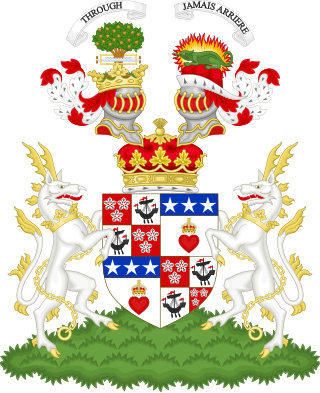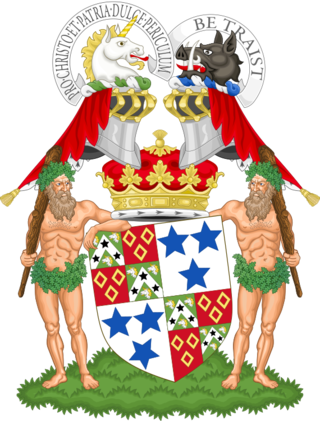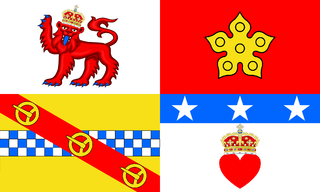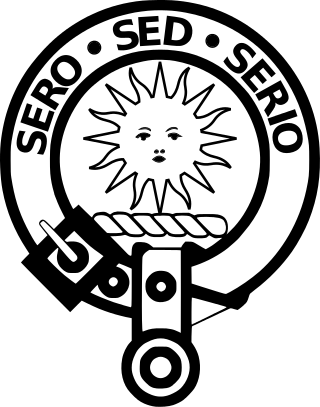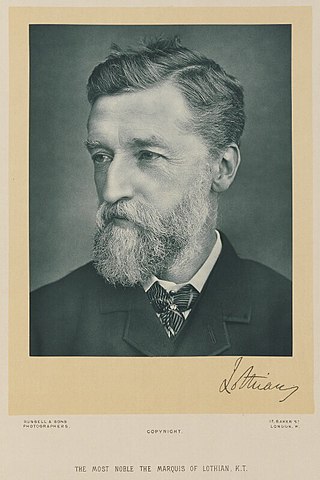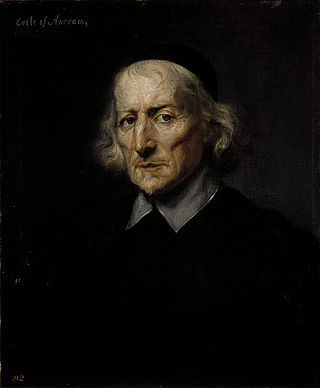This article needs additional citations for verification .(March 2008) |
| Marquessate of Lothian | |
|---|---|
 Arms: Quarterly: 1st & 4th, Azure, a Sun-in-Splendour proper (Lothian, as a coat of augmentation); 2nd & 3rd, Gules, on a Chevron Argent, three Mullets Gules (Kerr of Jedburgh). Crests: 1st, A Sun-in-Splendour proper (Lothian); 2nd, A Stag's Head cabossed Argent (Kerr of Jedburgh). Supporters: Dexter: An Angel proper, vested Azure, surcoated Vert, winged and crined Or; Sinister: A Unicorn Argent, armed crined and unguled Or, gorged with a Collar Gules, charged with three Mullets Argent. | |
| Creation date | 23 June 1701 |
| Created by | William III & II |
| Peerage | Peerage of Scotland |
| First holder | Robert Kerr, 4th Earl of Lothian |
| Present holder | Michael Kerr, 13th Marquess of Lothian |
| Heir presumptive | Lord Ralph Kerr |
| Remainder to | Heirs male whatsoever |
| Subsidiary titles | Earl of Lothian Earl of Ancram (1633) Earl of Ancram (1701) Viscount of Briene Lord Newbattle Lord Jedburgh Lord Kerr of Newbattle Lord Kerr of Nisbet, Langnewtoun, and Dolphinstoun Baron Ker (Peerage of the United Kingdom) |
| Status | Extant |
| Seat(s) | Ferniehirst Castle |
| Former seat(s) | Newbattle Abbey Blickling Hall |
| Motto | SERO SED SERIO (Late, but in earnest) |
Marquess of Lothian is a title in the Peerage of Scotland, which was created in 1701 for Robert Kerr, 4th Earl of Lothian. The Marquess of Lothian holds the subsidiary titles of Earl of Lothian (created 1606), Earl of Lothian (created again 1631), Earl of Ancram (1633), Earl of Ancram (created again 1701), Viscount of Briene (1701), Lord Newbattle (1591), Lord Jedburgh (1622), Lord Kerr of Newbattle (1631), Lord Kerr of Nisbet, Langnewtoun, and Dolphinstoun (1633), Lord Kerr of Newbattle, Oxnam, Jedburgh, Dolphinstoun and Nisbet (1701), and Baron Ker, of Kersheugh in the County of Roxburgh (1821), all but the last in the Peerage of Scotland. As The Lord Ker in the Peerage of the United Kingdom, previous marquesses sat in the House of Lords before 1963, when Scottish peers first sat in the House of Lords in their own right. The holder of the marquessate is also the Chief of Clan Kerr.
Contents
- History of the titles
- 1st title
- 2nd title as Marquess
- Earls of Lothian; First creation (1606)
- Earls of Lothian; Second creation (1631)
- Lords Jedburgh (1621/2)
- Earls of Ancram (1633)
- Marquesses of Lothian (1701)
- Family tree and succession
- See also
- References
- External links
The current Marquess of Lothian, the 13th, is better known as the Conservative politician Michael Ancram. In November 2010, he received a life peerage as Baron Kerr of Monteviot and so became entitled to sit in the House of Lords. He lives at Monteviot House in Roxburghshire. The family previously owned a larger Scottish seat, Newbattle Abbey in Midlothian, which is now a college, and also Blickling Hall in Norfolk, which now belongs to the National Trust.
The heir presumptive to the marquessate is the 13th Marquess' younger brother Lord Ralph Kerr, who owns Ferniehirst Castle in Roxburghshire, which is the family seat that was restored by the 12th Marquess, and Melbourne Hall in Derbyshire.
